They say those who climb the seven sacred hills of Tirumala aren’t called by chance — they’re invited by Lord Venkateswara himself. A visit to the Tirupati Balaji Temple is not just a journey of faith. It’s an awakening of surrender, where belief transcends reason.
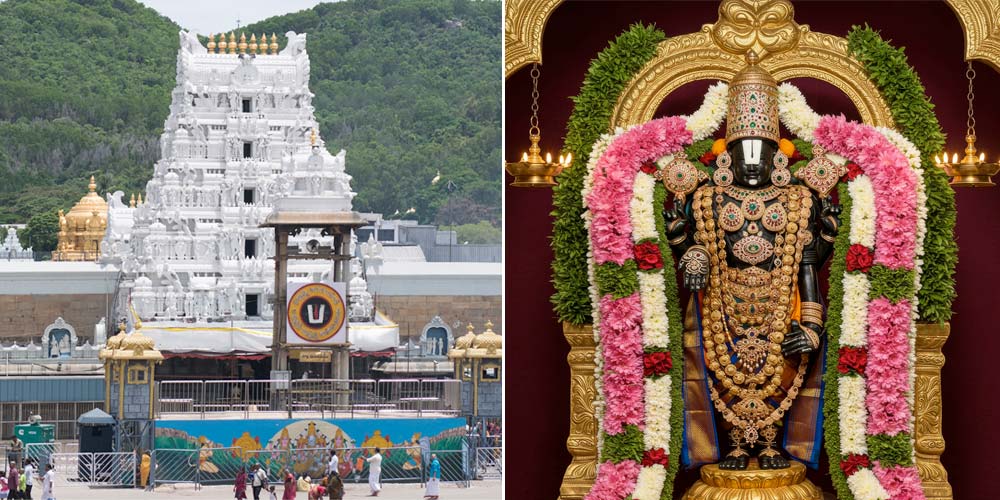
My professional journey spanning over 30 years has often taken me across places and cultures. Each travel experience has been a classroom in awareness. A reminder that devotion and mindfulness share the same essence. Letting go, trusting the process, and aligning thought with higher purpose. The timeless rituals at Tirumala Temple, every chant, every offering, every bow becomes a step inward.
In this article, I explore the legend of Lord Venkateswara, the sacred ritual of hair offering in Tirupati. Deeper mindfulness woven into the temple’s practices. Faith here transforms into awareness1, and surrender blossoms into peace.
Also Read:
- The Power of NLP: How Mind Techniques Shape Success Today
- Chorabari Tal: Exploring Shiva’s Sacred Himalayan Abode
- The Eternal Light of Mahadev: Journey Through the 12 Jyotirlingas of India
The Divine Origins of Lord Venkateswara
Every legend carries a lesson in faith. The story of Lord Venkateswara, also known as Tirupati Balaji, is a divine tale of love, patience, and purpose. Every offering made by devotees at the Tirupati Balaji Temple is believed to help repay this divine debt.
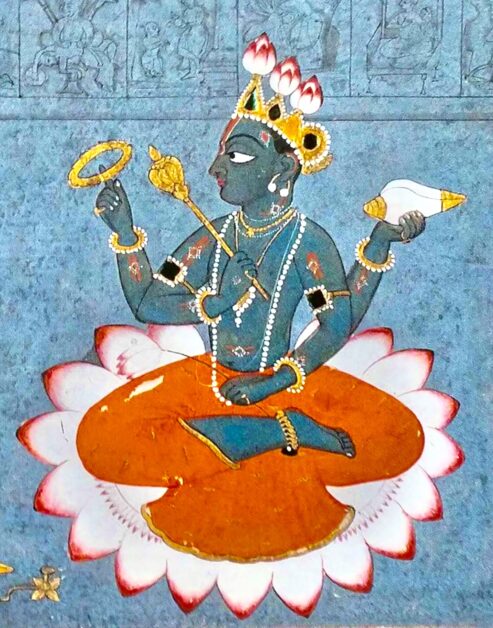
The temple today is managed by Tirumala Tirupati Devasthanams (TTD), a sacred trust that preserves the rituals, architecture, and sanctity of Lord Venkateswara’s abode.
Tirupati Balaji Story
According to ancient scriptures, when Goddess Lakshmi left Vaikuntha after a disagreement with Lord Vishnu. The universe trembled in imbalance. Unable to bear her absence, Vishnu descended to Earth as Srinivasa, seeking his beloved. His journey led him to the sacred Tirumala hills. Here destiny awaited in the form of Princess Padmavati. She was an incarnation of Lakshmi herself, born as the daughter of King Akasha Raja and Queen Dharanidevi.

This legend forms an important chapter in Vaishnavism, one of Hinduism’s principal traditions that worships Lord Vishnu as the Supreme Being. Followers see Tirumala as the earthly embodiment of Vishnu’s grace, where devotion transforms into mindfulness through daily rituals and sacred chants.
The Divine Meeting
The meeting was of Srinivasa and Princess Padmavati was destined. Srinivasa, enchanted by her grace, sought to marry Padmavati. Yet, even the divine must honor worldly customs. To arrange their celestial wedding, Srinivasa borrowed gold from Kubera, the Lord of Wealth, promising to repay the debt over time.
That vow continues through ages. Every offering made by devotees at the Tirupati Balaji Temple is believed to help repay this divine debt—a beautiful symbol of shared faith and gratitude. Here, the divine and human realms unite through devotion.
What does the Tirupati Balaji story teach us?
The legend of Venkateswara and Lakshmi is more than myth; it is a mindful reflection on love, duty, and surrender. Each devotee’s act of giving mirrors the Lord’s own promise—faith repaying faith.
Key reflections from the story
The story of Lord Venkateswara opens the path to understanding the history of Tirupati. It reminds us that every legend shapes faith, devotion, and the sacred continuity of Tirumala’s heritage.
- The descent of Vishnu as Srinivasa marks divine compassion in human form.
- The union of Padmavati and Srinivasa symbolizes balance between grace and responsibility.
- The debt to Kubera teaches humility and collective duty through offerings.
- The Tirumala temple stands as a living embodiment of gratitude and mindfulness.
The story of Lord Venkateswara prepares the heart to understand his divine presence. These reflections lead naturally into key facts about Tirumala’s living deity.

Facts about Lord Venkateswara
Before diving into the legends of Tirupati, let’s know a few key facts about Lord Venkateswara. Facts that reveal why Tirupati remains one of the world’s most revered spiritual centers.
- A Form of Lord Vishnu. Lord Venkateswara is considered an incarnation of Vishnu, the preserver in the Hindu Trinity.
- The Swayambhu Form: The main idol of Lord Venkateswara is believed to be self-manifested, i.e not crafted by human hands. It symbolizes pure spiritual energy taking physical form to bless humanity.
- The Mysterious Hair: According to sacred belief, the idol of Lord Venkateswara possesses real, silky hair that never tangles or requires trimming.
- Popular Names. Lovingly called Balaji, Srinivasa, Govinda, and Venkatachalapathi—each name reflecting a different aspect.
- Sacred Location. Main temple stands atop the Tirumala Hills in Andhra Pradesh.
- Divine Significance. Venkateswara is worshipped as the protector of dharma and the granter of moksha.
- Eternal Consorts. He is accompanied by Sridevi and Bhudevi. Symbolizing prosperity, compassion, and the nurturing force of creation.
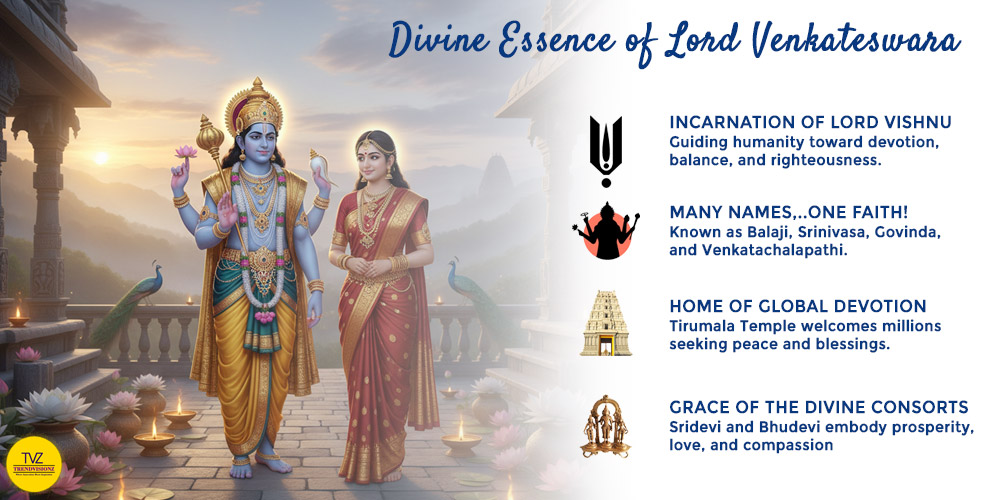
These timeless facts set the foundation for understanding Tirumala’s greatness. Beyond legend and devotion lies a temple shaped by history, architecture, and faith—the sacred home of Lord Venkateswara’s eternal presence.
Tirumala Temple: History and Sacred Symbolism
Standing atop the Seshachalam Hills in Andhra Pradesh, the Tirumala Temple is more than a structure of stone and gold. An unbroken thread of faith woven through centuries of devotion. Its origins trace back to the early dynasties of South India, including the Pallavas, Cholas, and Vijayanagara kings, who each contributed to its grandeur and upkeep.
The temple’s sanctum, plated in gold, radiates a divine brilliance said to mirror the spiritual wealth of those who enter with a pure heart. Today, the temple is managed by the TTD, ensuring that ancient customs continue with precision while embracing modern-day organization and transparency.
Why is the Tirumala Temple considered so sacred?
Its spiritual magnetism lies in the belief that Lord Venkateswara’s presence on Earth fulfills human prayers and restores balance. More than 100,000 pilgrims visit daily, drawn by its sacred vibration and timeless serenity.
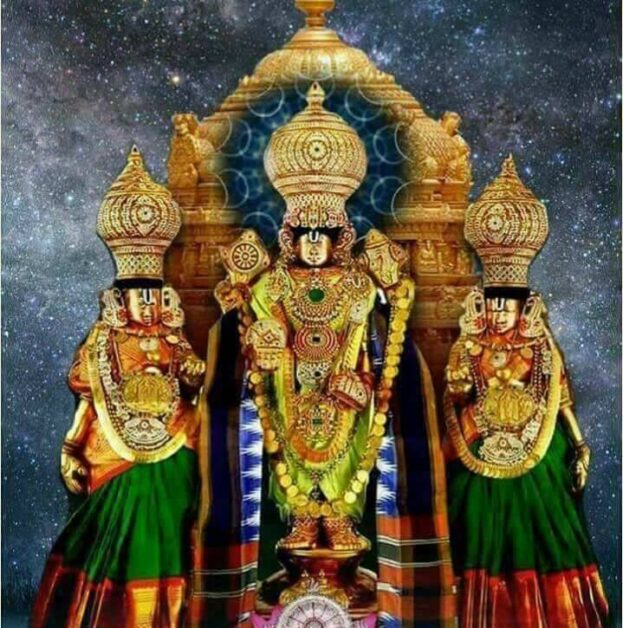
Highlights of the temple’s heritage
The Tirumala Temple stands as a living museum of devotion and architecture, where centuries of artistry and faith blend seamlessly to create one of India’s most revered spiritual landmarks.
- Golden sanctum symbolizing divine light
- Rich Dravidian architecture inspired by cosmic design
- Unbroken daily rituals preserving ancient tradition
The history of Tirupati is not merely recorded in scriptures—it lives in every prayer, every footstep, and every offering that continues to define its eternal significance.
Temple Economy and Offerings
The Tirumala Tirupati Devasthanams (TTD), which manages the temple, stands among the richest and most efficiently run religious institutions in India. For the 2025–26 financial year, its total projected revenue2 is around ₹5,259 crore. The largest share comes from devotees’ donations through the Hundi collection (₹1,729 crore), followed by interest on investments (₹1,310 crore) and the sale of prasadam (₹600 crore). Additional income is generated from darshan and seva tickets.
These figures reflect not opulence but faith in motion. Millions contribute with devotion, sustaining pilgrim welfare and support the temple’s social, educational, and charitable initiatives across Andhra Pradesh.
Hair Offering in Tirupati: Origin, Devotion, and Rituals
A question many devotees often ask is — why do people offer their hair at Tirupati? To understand this sacred act, we must first explore the deeper meaning behind the ritual itself. Among all the rituals at the Tirumala Temple, the act of offering hair holds the deepest symbolism. It is a visible gesture of inner surrender. A choice to let go of pride and walk in humility before Lord Venkateswara.
The origin of this sacred act is found in legend. Once, Lord Venkateswara was struck on the head during a quarrel. A Gandharva princess named Neela Devi saw the wound and compassionately cut a lock of her own hair to cover it. Moved by her devotion, the Lord blessed her, declaring that every offering of hair made at Tirumala would honor her sacrifice. From that moment, the tradition of hair donation became a way for devotees to express gratitude and surrender.
Why do people donate hair at Tirupati?
Every year, millions of devotees of all ages, men, women, and even children, offer their hair at the temple. For many, it marks a new beginning. Parents bring their children for their first tonsure as an act of purification. Others do it after prayers are fulfilled, seeing it as a mindful way to release attachments.
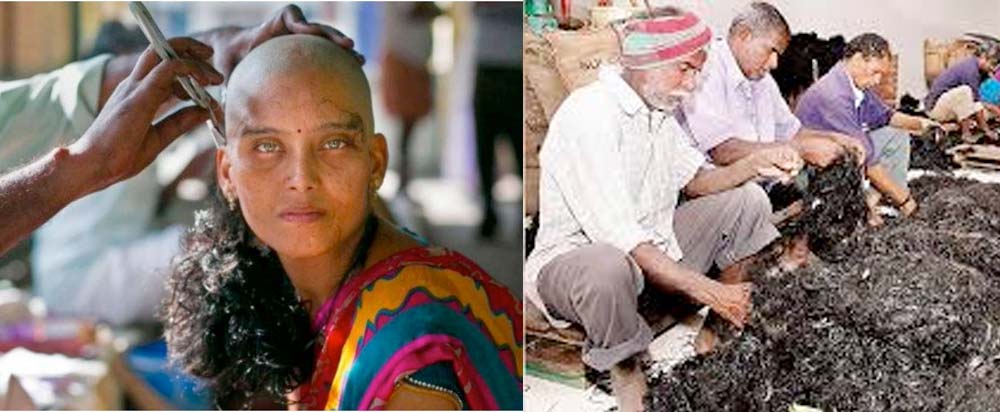
Reasons devotees offer hair at Tirupati
Each devotee arrives with a personal reason. But every offering carries the same essence. Gratitude, surrender, and faith in Lord Venkateswara’s boundless compassion and grace.
- Fulfillment of a Vow – Many devotees shave their heads once a prayer or promise to the Lord is fulfilled, offering gratitude through action.
- Letting Go of Ego – Hair symbolizes vanity. Removing it represents the shedding of pride, allowing one to experience true humility and spiritual clarity.
- Beginning Anew – Parents often bring children for their first tonsure, marking purity, protection, and blessings for a fresh start in life.
- Family and Tradition – Generations uphold this practice as a legacy of faith, binding families through shared devotion and collective spiritual renewal.
- Mindful Surrender – For seekers, the act itself becomes meditation—a release of attachment, turning surrender into peace and awareness.
Many devotees, from ordinary pilgrims to public figures, have taken part in this sacred ritual of surrender. As art patron Shalini Passi shared to NDTV,
“Even for me, when I shaved my hair at Tirupati, I shaved it four times. So for me also, I don’t want to style my hair much. Because ultimately, I will donate it- Shalini Passi, Artist and Philanthropist
While faith sustains the temple’s economy, devotion takes its purest form through the humble act of hair offering
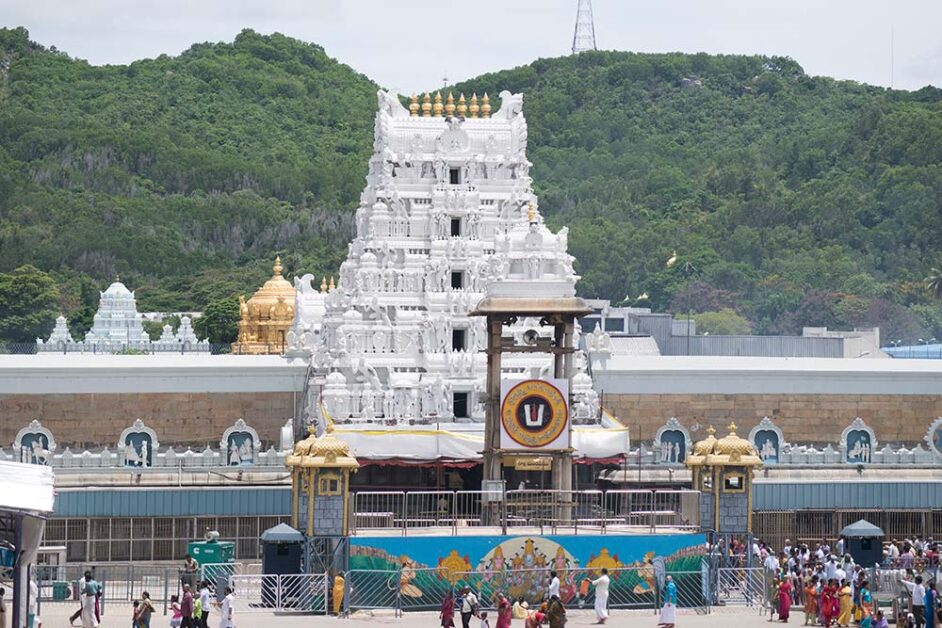
Sevas at Tirumala: A Devotee’s Offering
Devotion at the Tirumala Temple extends far beyond the act of offering hair. For many pilgrims, true service lies in participating in the daily and weekly sevas organized by the Tirumala Tirupati Devasthanams (TTD). These sacred rituals create a bridge between the devotee and Lord Venkateswara through prayer, music, and gratitude.
Every day begins with the Suprabhatam Seva, the ritual that awakens the Lord with hymns and chants. The Archana follows, where priests recite the thousand names of Vishnu, invoking divine blessings for devotees. The Kalyanotsavam, a symbolic wedding ceremony of Lord Venkateswara and Goddess Padmavati, celebrates the eternal union of love and faith.
Popular sevas performed at Tirumala
Each seva at Tirumala offers a unique path to connect with Lord Venkateswara. Some express gratitude, others devotion, but all share one purpose — to honor the divine presence through mindful service and faith.
- Suprabhatam – early morning awakening of the Lord
- Archana – reciting divine names for prosperity and peace
- Kalyanotsavam – symbolic celestial wedding of Venkateswara and Padmavati
- Abhishekam – ritual bathing of the deity with milk and flowers
- Vastralankara Seva – adorning the Lord with new garments and jewels
Participating in a seva at Tirumala is an act of mindfulness. Each chant and offering becomes a moment of stillness where gratitude deepens, reminding devotees that serving the divine is also a way of finding peace within.
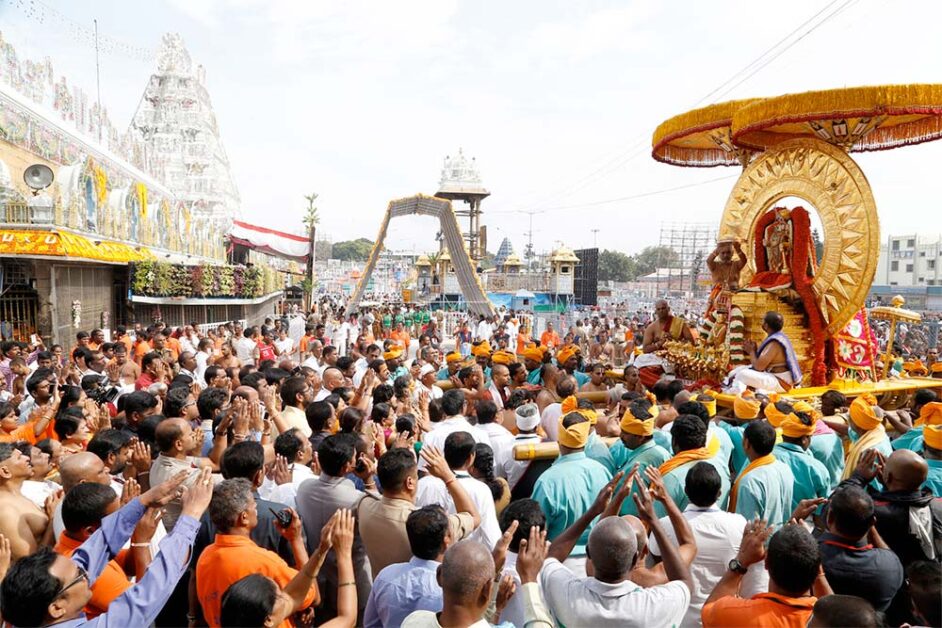
The Brahmotsavam festival at Tirumala brings devotion alive. Thousands gather to witness Lord Venkateswara’s golden chariot procession, celebrating faith, music, and divine energy under the temple’s sacred lights. During Brahmotsavam, the temple has over half a million devotees in a day. This feat makes it one of the busiest religious sites worldwide.
The Modern-Day Appeal of Lord Venkateswara
The devotion toward Lord Venkateswara has not faded with time; it has simply evolved. In a world driven by technology, faith at the Tirupati Balaji Temple continues to thrive.
How technology preserves devotion
Even today, devotees of Venkateswara Swamy connect through digital seva and online darshan. Through online sevas, live darshan, and digital donations, faith now flows seamlessly between sacred traditions and the modern world.
- Online Seva Bookings – Devotees now reserve their sevas digitally through the Tirumala Tirupati Devasthanams (TTD) website, ensuring equal access and transparency in participation.
- Live Darshan Streaming – Millions watch daily rituals from their homes, experiencing the same spiritual connection through virtual presence and prayer.
- Digital Donations – Offerings to Lord Venkateswara now happen online, making charity simple, secure, and global. These funds support temple services and community welfare.
- Virtual Queue Management – Technology organizes pilgrim flow efficiently. Ensuring safety while maintaining the temple’s sacred rhythm.
Faith has adapted beautifully. CEOs during board meetings to school children joining virtual darshans. TTD extends its mission through hospitals, educational institutions, and food programs like Annadanam. The temple’s outreach reflects the spirit of Vaishnavism.
The Swayambhu idol of Lord Venkateswara stands as a beacon in Kali Yuga. Devotees offer vows (Mokku) and return in gratitude. Experiencing divine grace through fulfilled wishes and heartfelt surrender.
Modern Miracle at Tirumala
It was during a severe drought in 1979, that Varuna Japam was performed at Tirumala. Temple bells rang on their own after the final seva, a divine sign. As prayers ended, rain poured only over the temple, filling the dam. This is a living miracle reaffirming Lord Venkateswara’s grace in the modern world.
The temple of Tirupati stands as proof that devotion knows no distance. Lord Venkateswara remains timeless. Connecting tradition with transformation in every believer’s journey.
How to Reach Tirupati
Reaching Tirupati is simple and convenient, with excellent connectivity for pilgrims from across India and abroad. The city’s transport network makes visiting the Tirumala Temple a comfortable spiritual journey.
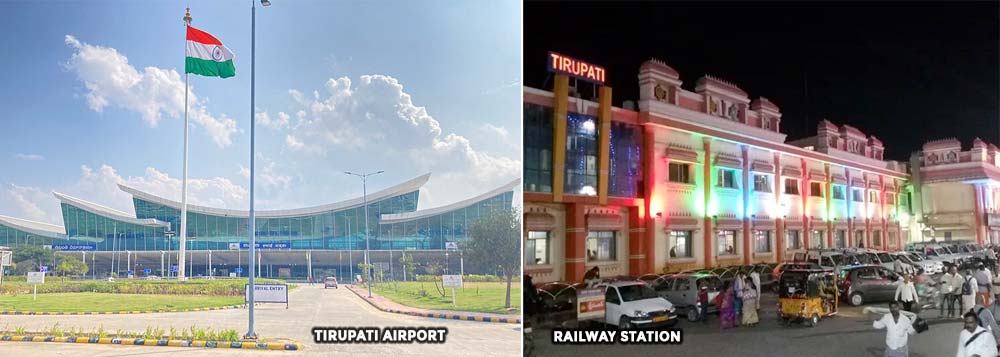
Ways to reach Tirupati:
- By Air: Tirupati Airport, located in Renigunta, connects major cities like Delhi, Mumbai, Hyderabad, and Chennai through daily flights.
- By Rail: Tirupati Railway Station is a major junction with frequent trains from across India, offering easy access to the foothills of Tirumala.
- By Road: Regular state-run and private buses link Tirupati with Chennai, Bengaluru, and Hyderabad through scenic, well-maintained highways.
Traveling to Tirupati is not just a route—it’s the beginning of a sacred experience that blends devotion, serenity, and discovery.
Also Read:
- The Eternal Light of Mahadev: Journey Through the 12 Jyotirlingas of India
- Lord Hanuman Story: Divine Birth, Powers, and the Symbolism
FAQs : Lord Venkateswara
What is the story behind Tirupati Balaji?
Tirupati Balaji is an incarnation of Lord Vishnu who descended to Earth. He married Goddess Padmavati, and vowed to repay a divine debt to Kubera. The legend blends myth and mindfulness, teaching that true faith lies in giving, serving, and evolving.
How does the hair offering happen at Tirumala?
The tonsure takes place at Kalyanakatta, managed by Tirumala Tirupati Devasthanams. Pilgrims shave their heads with devotion, offering hair as a symbol of humility. The collected hair is ethically auctioned to support temple welfare programs.
Which is the best seva in Tirumala?
Each seva carries unique significance. Many devotees consider Suprabhatam and Kalyanotsavam the most spiritually uplifting. These ceremonies allow worshippers to experience closeness to the divine.
How does the Tirumala Tirupati Devasthanams (TTD) utilize temple earnings?
TTD’s annual revenue crosses several thousand crores, generated through offerings, donations, and services. The funds are used for temple maintenance, pilgrim facilities, education, hospitals.
A Legacy of Love and Devotion
Tirupati stands as a living reminder that devotion and transformation walk hand in hand. Each pilgrim’s offering—whether hair, time, or prayer—reflects the eternal bond between faith and self-awareness. Lord Venkateswara continues to receive devotional hearts filled with humility and love.
At TrendVisionz, we celebrate stories that bridge tradition and mindfulness. Through research, reflection, and meaningful storytelling, we aim to connect ancient wisdom with modern life. Stay inspired, stay curious, and join us in exploring more narratives that nurture awareness, gratitude, and purpose. Visit TrendVisionz to discover more.
Additional Resources:
- Gautam, P. (2025). Tirumala Tirupati Devasthanam: Sacred Heritage and Development Strategy. Journal of Tourism & Adventure, 8(1), 84–100. https://doi.org/10.3126/jota.v8i1.82635 ↩︎
- Mukkavilli, S. (2019). A study of revenue management of Tirumala Tirupati Devasthanam: Management control of religious trust in India. ↩︎
Stay Connected with Me:
Anuj Mahajan is a Mass Communication Specialist, ICF-ACC Certified Coach, Corporate Trainer, Motivational Speaker, NLP Life Coach, Filmmaker, and Author. With 30+ years in media, marketing, and leadership coaching, he unites storytelling, mindfulness, and digital transformation.
- Explore my work: Nuteq Entertainment | TrendVisionz | Author Profile
- Read our newsletters: Transforming Lives | BizTech Chronicle | Nuteq Newsline
- Guest writer: BizCatalyst360 | Praja Today
- Books: Go Mindfulness: Practices for Professionals Coached
- Join the community: LinkedIn Group – Digital Marketing & Content Creation World
- Connect with me: LinkedIn | Twitter | #StoryforBusiness
- Share your review: Leave your review on Google — your feedback helps us grow.
- Listen on Spotify: Leadership Podcast | Guided NLP (7 Episodes) | Daily Motivation – 21 Episodes
Believe. Practice. Perform. Let’s create impact together.
✍️ A Note from the Editor
Independent storytelling thrives with you. Contribute $15/month via PayPal or email us at anujmahajan@trendvisionz.com. [Guest write for us — Free or Paid.]


2 comments
[…] Posts Tirumala’s Lord Venkateswara: The Eternal Presence of Faith The Modern Fauji Wife: Entrepreneurs of Grace and Grit Everyday Skincare for Urban Living and […]
[…] Posts Tirumala’s Lord Venkateswara: The Eternal Presence of Faith The Modern Fauji Wife: Entrepreneurs of Grace and Grit Everyday Skincare for Urban Living and […]